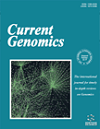- Home
- A-Z Publications
- Current Genomics
- Previous Issues
- Volume 13, Issue 4, 2012
Current Genomics - Volume 13, Issue 4, 2012
Volume 13, Issue 4, 2012
-
-
Collective Epithelial and Mesenchymal Cell Migration During Gastrulation
More LessAuthors: Manli Chuai, David Hughes and Cornelis J. WeijerGastrulation, the process that puts the three major germlayers, the ectoderm, mesoderm and endoderm in their correct topological position in the developing embryo, is characterised by extensive highly organised collective cell migration of epithelial and mesenchymal cells. We discuss current knowledge and insights in the mechanisms controlling these cell behaviours during gastrulation in the chick embryo. We discuss several i Read More
-
-
-
Building a Robust A-P Axis
More LessAuthors: Alysha Heimberg and Edwina McGlinnSince the last common ancestor of Metazoa, animals have evolved complex body plans with specialized cells and spatial organization of tissues and organs. Arguably, one of the most significant innovations during animal evolutionary history was the establishment of a bilateral plane of symmetry on which morphological features (e.g. tissues, organs, appendages, skeleton) could be given specific coordinates within the animal along Read More
-
-
-
From Lizard to Snake; Behind the Evolution of an Extreme Body Plan
More LessThe elongated, snake-like skeleton, as it has convergently evolved in numerous reptilian and amphibian lineages, is from a developmental biologist’s point of view amongst the most fascinating anatomical peculiarities in the animal kingdom. This type of body plan is characterized by a greatly increased number of vertebrae, a reduction of skeletal regionalization along the primary body axis and loss of the limbs. Recent Read More
-
-
-
Time Space Translation: A Hox Mechanism for Vertebrate A-P Patterning
More LessAuthors: A. J. Durston, S. Wacker, N. Bardine and H. J. JansenThe vertebrate A-P axis is a time axis. The head is made first and more and more posterior levels are made at later and later stages. This is different to the situation in most other animals, for example, in Drosophila. Central to this timing is Hox temporal collinearity (see below). This occurs rarely in the animal kingdom but is characteristic of vertebrates and is used to generate the primary axial Hox pattern using time Read More
-
-
-
Epigenome-Wide Association Studies (EWAS) in Cancer
More LessBy Mukesh VermaAfter completion of the human genome, genome-wide association studies were conducted to identify single nucleotide polymorphisms (SNPs) associated with cancer initiation and progression. Most of the studies identified SNPs that were located outside the coding region, and the odds ratios were too low to implement in clinical practice. Although the genome gives information about genome sequence and structure, the Read More
-
-
-
The Pharmacogenomic HLA Biomarker Associated to Adverse Abacavir Reactions: Comparative Analysis of Different Genotyping Methods
More LessMany pharmacogenomic biomarkers (PGBM) were identified and translated into clinical practice, affecting the usage of drugs via label updates. In this context, abacavir is one of the most brilliant examples of pharmacogenetic studies translated into clinical practice. Pharmacogenetic studies have revealed that abacavir HSRs are highly associated with the major histocompatibility complex class I. Large studies established the Read More
-
-
-
Identification of Pharmacological Targets in Amyotrophic Lateral Sclerosis Through Genomic Analysis of Deregulated Genes and Pathways
More LessAuthors: Sabrina Paratore, Salvatore Pezzino and Sebastiano CavallaroAmyotrophic Lateral Sclerosis (ALS) is a progressive and disabling neurodegenerative disorder characterized by upper and lower motor neuron loss, leading to respiratory insufficiency and death after 3-5 years. Riluzole is currently the only FDA approved drug for ALS, but it has only modest effects on survival. The majority of ALS cases are sporadic and probably associated to a multifactorial etiology. With the completion of g Read More
-
-
-
Challenges and Solutions in the Development of Genomic Biomarker Panels: A Systematic Phased Approach
More LessAuthors: K. Shahzad, A. Fatima, M. Cadeiras, N. Wisniewski, G. Bondar, R. Cheng, E. Reed and M. C. DengIn the post-genome era, high throughput gene expression profiling has been successfully used to develop genomic biomarker panels (GBP) that can be integrated into clinical decision making. The development of GBPs in the context of personalized medicine is a scientifically challenging and resource-intense process. It needs to be accomplished in a systematic phased approach to address biological variation related to a clinic Read More
-
Volumes & issues
-
Volume 26 (2025)
-
Volume 25 (2024)
-
Volume 24 (2023)
-
Volume 23 (2022)
-
Volume 22 (2021)
-
Volume 21 (2020)
-
Volume 20 (2019)
-
Volume 19 (2018)
-
Volume 18 (2017)
-
Volume 17 (2016)
-
Volume 16 (2015)
-
Volume 15 (2014)
-
Volume 14 (2013)
-
Volume 13 (2012)
-
Volume 12 (2011)
-
Volume 11 (2010)
-
Volume 10 (2009)
-
Volume 9 (2008)
-
Volume 8 (2007)
-
Volume 7 (2006)
-
Volume 6 (2005)
-
Volume 5 (2004)
-
Volume 4 (2003)
-
Volume 3 (2002)
-
Volume 2 (2001)
-
Volume 1 (2000)
Most Read This Month
Article
content/journals/cg
Journal
10
5
false
en


